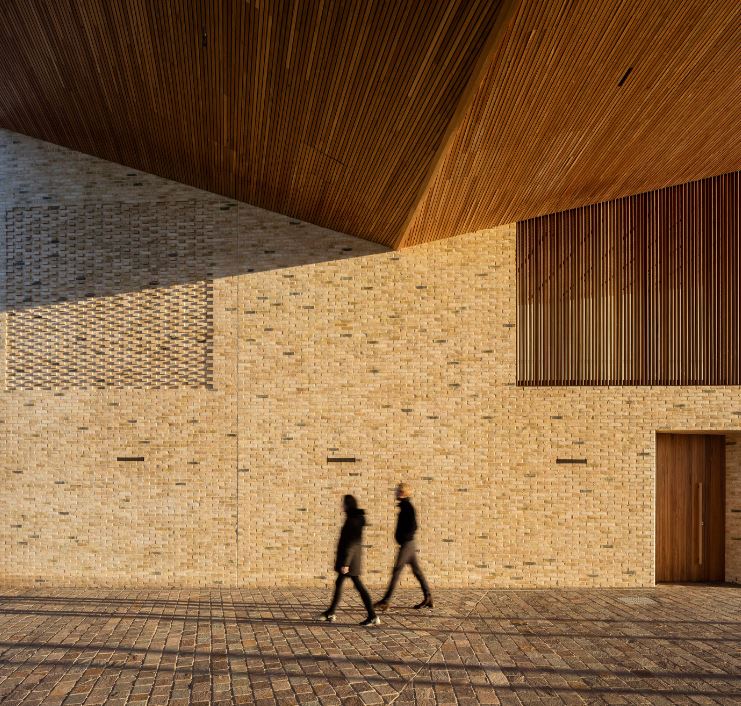FRI 5 JULY –Winners of the 2019 New South Wales (NSW) Architecture Awards have been announced, honouring the state’s leading architecture, with public projects dominating across multiple categories.
Across 12 categories, 51 awards were given including named awards, architecture awards andcommendations from 97 shortlisted projects and 212 entries. Awards were also given to outstanding public and commercial projects across the NSW Architecture Medallion, 2019 NSW Premier’s Prize, 2019 City of Sydney Lord Mayor’s Prize, Blacket Prize and Enduring Award categories.
The winners were announced at a dinner hosted in Sydney by the NSW Chapter of the Australian Institute of Architects on Friday 5 July.
The prestigious NSW Architecture Medallion, honouring an exemplary project across all awards categories, was given to Maitland Riverlink by CHROFI with McGregor Coxall for illustrating the power of architecture in the civic realm by improving connectivity between the Hunter River and the main street of Maitland.
Peter Poulet, Chair of Juries for this year’s NSW awards program, describes the Maitland Riverlink project as an architectural centrepiece that improves connectivity and celebrates the history, value and ambition of Maitland in regional NSW.
‘A strong civic gesture, this building acts as a public living room, attracting and celebrating the coming together of the community. The town and its river and proves the power of public architecture to deliver change, celebration and a legacy for the future,’ says Poulet.
Another one of the evening’s most recognised projects was Green Square Library and Plaza by Studio Hollenstein in association with Stewart Architecture and HASSELL, which took four awards including the John Verge Award for Interior Architecture, two architecture awards across the Public Architecture and Urban Design categories and the 2019 NSW Premier’s Prize.
Sandra Furtado, Jury Chair for Interior Architecture and Commercial Architecture, acknowledged that the Green Square Library and Plaza reflected the integral role libraries are playing in supporting a city’s social infrastructure.
‘It is immediately obvious that this library is loved by its staff and the wider community – this building is already the vibrant heart of the community,’ says Furtado.
NSW Chapter President Kathlyn Loseby says that the awards are a time to reflect and celebrate the role that great architecture plays across the state.
‘The strength of our industry and its impact on the places we live is undeniably positive and at times revolutionary. Today we celebrate with our clients, consultants and contractors who helped make these projects come to life, and for the fortunate people who live, work and play in these environments which are designed to stand the test of time,’ says Loseby.
Loseby also highlighted the invaluable connection between good procurement practices and great design outcomes, a theme which resonated throughout this year’s winning projects. ‘Good design is far more than aesthetic achievement – it takes collaboration amongst willing clients, good builders and appropriate procurement methods to make it an enduring success,’ says Loseby.
‘The awards celebrate achievement and reward the best of 2019, it is an annual review of our professional output, our capacity, as well as our skills, potential and vision for a better built environment,’ adds Poulet.
Projects that received an architecture award or a named award will now progress to compete in the National Architecture Awards program. The shortlist will be announced by the Australian Institute of Architects in the coming months.
The full list of winners can be found below.
ENDS
MEDIA CONTACT:
Sophie Watson
Communications Collective
(03) 9988 2300
sophie@comunicationscollective.com.au
NOTES TO EDITOR:
High resolution images and jury citations are available for download by registering at –
https://nationalarchitecture.awardsplatform.com/profile/complete/lbyJlmXA
The National Architecture Awards and respective state and territory Architecture Awards programs are run by the Australian Institute of Architects. Images and information are provided only for use in articles relating to the Institute’s Architecture Awards. The Awards program must be attributed as the Australian Institute of Architects’ National/State/Territory Architecture Awards.
All images must credit the Institute, the architect and photographer. Use in any other context is strictly prohibited without written permission from the submitting architect.
2019 New South Wales Awards: Winners
Residential Architecture – Houses (New)
37 entries / 12 shortlisted projects / 2 commendations / 2 awards / 1 named
WILKINSON AWARD FOR RESIDENTIAL ARCHITECTURE (NEW)
GB House | Renato D’Ettorre Architects
ARCHITECTURE AWARDS
Merewether | SAVIO PARSONS
Sunrise House | MCK Architects
COMMENDATIONS
Castle Cove House | TERROIR
Bay Guarella | Peter Stutchbury Architecture
Residential Architecture – Houses (New) Jury
Ed Lippmann (Chair) | Lippmann Partnership
Miriam Green | Atelier M
Matt Chan | Scale Architecture
Linda Morris | Sydney Morning Herald
Residential Architecture – Multiple Housing
32 entries / 13 shortlisted projects / 2 commendations / 3 awards / 1 named
AARON BOLOT AWARD FOR RESIDENTIAL ARCHITECTURE – MULTIPLE HOUSING
North Rocks | Candalepas Associates
ARCHITECTURE AWARDS
Imperial | Stanisic Architects
Iglu Redfern | Bates Smart
OneA | Breakspear Architects and KANNFINCH
COMMENDATIONS
Arlington Grove | Smart Design Studio
Mezzo | CHROFI and KANNFINCH
Residential Architecture – Multiple Housing Jury
Conrad Johnston (Chair) | Fox Johnston
Ines Benavente-Molina | HDR
Paulo Macchia | Government Architect NSW
Residential Architecture – Houses (Alterations and Additions)
30 entries / 11 shortlisted projects / 1 commendations / 1 award / 1 named
HUGH AND EVA BUHRICH AWARD FOR RESIDENTIAL ARCHITECTURE – HOUSES
(ALTERATIONS AND ADDITIONS)
Five Gardens House | David Boyle Architect
ARCHITECTURE AWARDS
Redfern Warehouse | Ian Moore Architects
COMMENDATION
Moreton Manor | CO-AP (Architects)
Residential Architecture – Houses (Alterations and Additions) Jury
Ed Lippmann (Chair) | Lippmann Partnership
Miriam Green | Atelier M
Matt Chan | Scale Architecture
Linda Morris | Sydney Morning Herald
Interior Architecture
25 entries / 10 shortlisted projects / 2 commendations / 2 awards / 1 named
JOHN VERGE AWARD FOR INTERIOR ARCHITECTURE
Green Square Library and Plaza | Studio Hollenstein in association with Stewart
Architecture
ARCHITECTURE AWARDS
Castle Cove House | TERROIR in collaboration with Pascale Gomes- McNabb
Design
Dangrove | Tzannes
COMMENDATIONS
Redfern Warehouse | Ian Moore Architects
Caroma On Collins | Archier
Interior Architecture Jury
Sandra Furtado (Chair) | Furtado Sullivan
Tony Grist | HASSELL
Amber Stewart | ARM Architecture
Public Architecture
14 entries / 8 shortlisted projects / 1 commendation / 3 awards / 1 named
SULMAN MEDAL FOR PUBLIC ARCHITECTURE
Maitland Riverlink | CHROFI with McGregor Coxall
ARCHITECTURE AWARDS
Cabarita Park Conservatory | Sam Crawford Architects
Shellharbour Civic Centre | DesignInc in association with Lacoste+Stevenson
Green Square Library and Plaza | Studio Hollenstein in association with Stewart
Architecture
COMMENDATION
State Library of New South Wales | HASSELL
Public Architecture Jury
Jonathan Evans (Chair) | Tzannes
Jamileh Jahangiri | Cox Architecture
Jasmin Williamson | John Wardle Architects
Small Project Architecture
11 entries / 3 shortlisted projects / 1 commendation / 1 award / 1 named
ROBERT WOODWARD AWARD FOR SMALL PROJECT ARCHITECTURE
Bungarribee Parklands Shelters | Stanic Harding Architects with Paramatta Park &
Western Sydney Parklands Trusts
ARCHITECTURE AWARD
Renewal of the Opera House’s Joan Sutherland Theatre | Scott Carver
COMMENDATION
Punch Park Amenities | Carter Williamson Architects
Small Project Architecture Jury
Elisha Long (Chair) | Long Blackledge Architects
Ava Shirley | Peter Stutchbury Architecture
Luigi Rosselli | Luigi Rosselli Architects
Educational Architecture
18 entries / 10 shortlisted projects / 1 commendation / 3 awards / 1 named
WILLIAM E KEMP AWARD FOR EDUCATIONAL ARCHITECTURE
University of Sydney F23 Administration Building | Grimshaw Architects
ARCHITECTURE AWARDS
Taronga Institute of Science and Learning | NBRS ARCHITECTURE
St Pius X High School, Library | SHAC
Our Lady of the Assumption Catholic Primary School | BVN
COMMENDATION
The University of Sydney Life, Earth & Environmental Services Building | HDR
Educational Architecture Jury
Jonathan Evans (Chair) | Tzannes
Jamileh Jahangiri | Cox Architecture
Jasmin Williamson | John Wardle Architects
Urban Design
10 entries / 6 shortlisted projects / 1 commendation / 2 awards / 1 named
LLOYD REES AWARD FOR URBAN DESIGN
Harold Park | Mirvac Design, Government Architects Office (GANSW), City of
Sydney and HASSELL
ARCHITECTURE AWARDS
Green Square Library and Plaza | Studio Hollenstein in association with Stewart
Architecture and HASSELL
Maitland Riverlink | CHROFI with McGregor Coxall
COMMENDATION
Elizabeth Bay Marina | lahznimmo architects
Urban Design Jury
Conrad Johnston (Chair) | Fox Johnston
Ines Benavente-Molina | HDR
Paulo Macchia | Government Architect NSW
Heritage
14 entries / 9 shortlisted projects / 3 commendations / 3 awards / 1 named
GREENWAY AWARD FOR HERITAGE
House in Darlinghurst | Tribe Studio
ARCHITECTURE AWARDS
Tayim | Welsh + Major Architects
State Library of New South Wales | HASSELL
Paramount House Hotel | Breathe Architecture
COMMENDATIONS
Balmain Rock | Benn + Penna Architecture
The Burcham | Allen Jack+Cottier
St John’s College Library | Hector Abrahams Architects
Heritage Jury
Elisha Long (Chair) | Long Blackledge Architects
Ava Shirley | Peter Stutchbury Architecture
Luigi Rosselli | Luigi Rosselli Architects
Commercial Architecture
18 entries / 8 shortlisted projects / 3 commendations / 1 award / 1 named
SIR ARTHUR G. STEPHENSON AWARD FOR COMMERCIAL ARCHITECTURE
Dangrove | Tzannes
ARCHITECTURE AWARD
Paramount House Hotel | Breathe Architecture
COMMENDATIONS
Rail Operation Centre | Jacobs with Smart Design Studio
Barrack Place | Architectus
2 Bligh Street | Bates Smart
Commercial Architecture Jury
Sandra Furtado (Chair) | Furtado Sullivan
Tony Grist | HASSELL
Amber Stewart | ARM Architecture
Sustainable Architecture
7 shortlisted projects / 2 awards / 1 named
MILO DUNPHY AWARD FOR SUSTAINABLE ARCHITECTURE
Our Lady of the Assumption Catholic Primary School | BVN
ARCHITECTURE AWARDS
UNSW Roundhouse | Tonkin Zulaikha Greer
My Ideal House by Mirvac | Mirvac Design with Madeleine Blanchfield
Sustainable Architecture Jury
Rod Simpson (Chair) | Greater Sydney Commissioner
Mary Casey | HKA
Adam Russell | Roberts Day
COLORBOND® Award for Steel Architecture (NSW)
St Pius X High School, Library | SHAC
COLORBOND® Award Jury
Jonathan Evans | Tzannes (Jury Chair, Public Architecture and Educational Architecture)
Ed Lippmann | Lippmann Partnership (Jury Chair, Residential Architecture – Houses
(Alterations and Additions) / Houses (New)
Sandra Furtado | Furtado Sullivan (Jury Chair, Commercial Architecture and Interior
Architecture)
Conrad Johnston | Fox Johnston (Jury Chair, Residential Architecture – Multiple Housing
and Urban Design)
Elisha Long | Long Blackledge Architects (Jury Chair, Heritage and Small Project
Architecture)
Rod Simpson | simpson + wilson (Jury Chair, Sustainable Architecture)
NSW Architecture Medallion
Maitland Riverlink | CHROFI with McGregor Coxall
NSW Architecture Medallion Jury
Peter Poulet (Chair of Juries)
Jonathan Evans | Tzannes (Jury Chair, Public Architecture and Educational Architecture)
Ed Lippmann | Lippmann Partnership (Jury Chair, Residential Architecture – Houses
(Alterations and Additions) / Houses (New)
Conrad Johnston | Fox Johnston (Jury Chair, Residential Architecture – Multiple Housing
and Urban Design)
Sandra Furtado | Furtado Sullivan (Jury Chair, Commercial Architecture and Interior
Architecture)
Elisha Long | Long Blackledge Architects (Jury Chair, Heritage and Small Project
Architecture)
Rod Simpson | simpson + wilson (Jury Chair, Sustainable Architecture)
Kathlyn Loseby | Crone Architects (Jury Chair, Enduring Architecture)
2019 NSW Premier’s Prize
Green Square Library and Plaza | Studio Hollenstein in association with Stewart
Architecture and HASSELL
NSW Premier
Gladys Berejklian
2019 City of Sydney Lord Mayor’s Prize
Barrack Place | Architectus
Harold Park | Mirvac Design, Government Architects Office (GANSW), City of
Sydney and HASSELL
Lord Mayor of City of Sydney
Clover Moore
Blacket Prize
Maitland Riverlink | CHROFI with McGregor Coxall
Blacket Prize Jury
Nicholas Brown | Studio Two Architecture & Design (Country Division Representative)
Jodie Dixon | Jodie Dixon Architect (Newcastle Representative)
Jonathan Evans | Tzannes
Ed Lippmann | Lippmann Partnership
Sandra Furtado | Furtado Sullivan
Conrad Johnston | Fox Johnston
Elisha Long | Long Blackledge Architects
Rod Simpson | simpson + wilson
Enduring Architecture
350 George Street | Edward Raht
Enduring Award Jury
Kathlyn Loseby | Crone Architects (Jury Chair)
Jennifer Preston | JPA&D
Howard Tanner
Emerging Architect
Cameron Anderson | Cameron Anderson Architects
Emerging Architect Jury
Kathlyn Loseby | Crone Architects (Jury Chair)
Ben Coulston | TERROIR
Amelia Holliday | Aileen Sage Architects & 2018 Emerging Architect Prize Recipient
Isabelle Toland | Aileen Sage Architects & 2018 Emerging Architect Prize Recipient
Murray Chaloner | AWS



